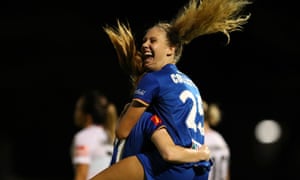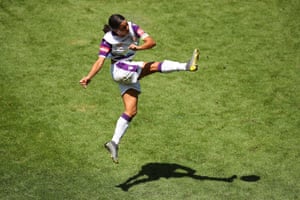It looks like a W-League team will happen eventually
Wide-reaching plans for independent W-League revealed
The future of the women’s game has finally been addressed with the goal of creating a sustainable, competitive and professional competition
Samantha Lewis

The APFCA, FFA, PFA and Women’s Council have been involved in drawing up a blueprint for the W-League.
Following the A-League’s decision to
sever ties with Football Federation Australia earlier this year, the future of the W-League – and, by extension, the Matildas – is at a crossroads. For all the talk of a new dawn for Australian football over the past year, there has been little to no mention of how independence will affect the women’s game.
But Guardian Australia can now reveal the plans for an independent
W-League – as part of a three-pronged approach to the men’s, women’s and e-sports competitions – which aims to transform the league into a sustainable, competitive, and professional competition over the coming years.
The information, gathered from a range of sources close to negotiations, is believed to be part of a dedicated strategy document that has been developed over the past four months by the Australian Professional Football Clubs Association (APFCA), and includes input from FFA, Professional Footballers Australia, member federations and the Women’s Council.
It is understood this will be used as the central blueprint for the league moving forward, ranging from short-term (one- to two-year) proposals to the longer-term (more than four years ). The plan can be organised into four key themes: players, clubs, the league and broadcasting.
Players
A priority for the independent body is retaining Australian internationals in the W-League. Combating interest from clubs overseas, the league aims to incentivise Matildas players and capitalise on the pulling power of the global brand. As such, player payments will gradually increase, while the salary cap will be lifted to $450,000 for the 2019-20 season. This will be the first season that the minimum hourly wage for W-League players will be brought into line with A-League players, as per
the CBA renewed earlier this year.
The marquee player program will continue, with every club eventually able to field a marquee player outside the cap, while the international player quota will gradually increase as the league expands. Finally, there is a long-term aim to develop a progressive maternity leave policy that includes financial and job security as well as postpartum player care and childcare.

Keeping Sam Kerr in the W-League for the coming season will be a boon for the competition.
Clubs
As part of the league’s “one club” philosophy, every A-League team will be required to have a W-League counterpart, with the long-term goal being 16 W-League teams in total. While there are concerns regarding a thinning local talent pool, the clubs believe expansion is necessary to attract more international players and provide more opportunities for youth. Club social media accounts will also be merged in line with the league’s unofficial slogan: “It’s not men’s football, it’s not women’s football, it’s just football.”
W-League sides will occupy one consistent home stadium outside of double-header games, with attention paid to accessibility, fan atmosphere and pitch quality. Elite training facilities will be developed in tandem with dedicated staff, equipment, and programs based on cutting-edge sports science. W-League licences will hinge on meeting minimum facility standards.
Every club will be supported to develop girls’ academies, ensuring that Australia continues to produce world-class footballers. One idea being floated is the creation of a national draft, where academy players are picked by clubs and distributed across the W-League to guarantee development opportunities for young talent.
The league
An extended home-and-away season is a short-term priority. While many fans and players had hoped this would be in place for the 2019-20 season, it is understood its implementation had been delayed due to the late administrative handover from FFA. Season length will gradually extend with expansion, with the long-term goal being parity with the A-League: 30 rounds plus a finals series.
A formal partnership with another domestic women’s league, likely the NWSL in the United States, is believed to be in the early planning stages. Based on calendar availability, other partnership options might include a league in Scandinavia or eastern Asia. This partnership could lay the foundation for multi-year contracts and official player loan agreements both to and from the W-League, with clubs likely paying loan fees and player salaries.
A new ticketing and pricing system will be developed that centralises all club data and charges fans accordingly, while W-League match-day experiences more generally will be overhauled. It is understood this includes: the implementation of safe standing areas to incentivise fans to participate more actively and collaboratively in games; showcasing matches in A-League stadiums; increasing the number of double-headers to attract bigger crowds; creating pre-match fan zones; and implementing half-time entertainment for women’s games.
The commercial branches of each club will be centralised and discussions with new and existing commercial partners ramped up, with an aim to recruit more appropriate brands to the league, such as women’s products and health foods. A renegotiation with league naming partner Westfield is also believed to be on the table, with multiple organisations thought to be ready to step in to further invest in the W-League off the back of the success of the World Cup.
Broadcasting
With the aid of a $30m government grant, Fox Sports and Kayo will continue to broadcast every W-League game for the next two seasons. Thursday (or “Hersday”) night football will return, while one game per round will be simulcast live on ABC on Sunday afternoons at 4:00pm, as well as the entire finals series.
A medium-term ambition is for every W-League match to be broadcast live, as well as expanding and improving digital and radio coverage generally. This may involve the development of a live feed or an over-the-top platform that can provide ongoing content both within and outside of games, including press conferences, interviews, training sessions and archived footage.
Fan engagement is another crucial area of development. By capitalising on digital platforms, including a plan to partner with a global football media outlet such as DugOut or Copa90, the league hopes to better capture the interest of younger fans and grassroots participants.
The final pillar of the strategy, which encompasses all the others, is a commitment to gender equality across the league. It is understood this involves clarifying and streamlining pathways for women in Australian football, including supporting female coaches who may want to coach men’s teams, and any other women who want to work in the top tiers of the Australian game.
These changes are believed to be part of a long-term strategy that seeks to make the W-League a more sustainable and professional competition. How these changes will work in practice, and the consequences for failing to abide by the pillars established by the independent body, remains to be seen.
https://www.theguardian.com/footbal...ching-plans-for-independent-w-league-revealed


